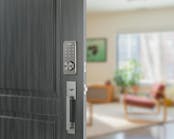The next generation SmartCode Signature series uses a more compact and sleeker outer escutcheon plate, making it look much more like original door hardware instead of an aftermarket add-on.
In addition to the new escutcheon design, the Kwikset pin tumbler lock cylinder formerly used in Powerbolt locks has been replaced in Signature Series deadbolts with the Kwikset SmartKey sidebar locking system. According to Kwikset, the patented sidebar locking design with BumpGuard protection passes ANSI Grade 1 lock picking standards. A second advantage to the SmartKey system is that the combination can be quickly changed without removing the lock cylinder from the door.
Two different codes can be used to operate the SmartCode. The primary code is designed for all users, and a secondary code is designed for temporary access such as when workmen or other visitors require access.
A sliding panel on the interior escutcheon plate reveals a program button. To program the SmartCode, press the program button one time. The Smartcode is now ready to accept a new primary code. Input a new primary code by pressing the desired numbers on the outer keypad.
The new code must contain between 4 and 8 digits. Each button on the keypad contains two numbers such as 12,34,56,78 and 90. Therefore the same buttons would be pushed to obtain a code of 1111 or 2222. With up to eight possible digits in a combination, this still leaves a large amount of possible combinations.
Programming the secondary code is done by pressing the program button twice. The SmartCode is now ready to accept a new secondary code. The secondary code must also contain between 4 and 8 digits.
Once a new primary or secondary code has been set, press the ‘lock’ button on the key pad. The bolt will automatically extend to the locked position. Test the new combination by pressing the desired buttons. As the last button in the new combination is pressed, the bolt should automatically retract.
If the bolt does not retract, press the programming button once or twice depending on the whether you are programming a primary or secondary code, and re-enter the new code numbers on the keypad. Until SmartCode programming is complete, perform all trials with the door open to prevent a possible lockout.
A ‘setting’ switchbox is also located inside the inner escutcheon housing. There are three usable switch settings.
*Switch #1 turns an LED indicator light ‘on’. The indicator light is located on the inner escutcheon and is a visual indicator that the lock is operational.
*Switch #2 turns on an auto-lock feature. This feature automatically relocks the door 30 seconds after unlocking has taken place.
*Switch #3 enables an audible beep each time a button is pushed. When set to the ‘off’ position, each keypad button automatically lights as it is pressed.
A battery pack located in the inner escutcheon housing requires four AA batteries. Based on 15 operations per day, the instruction sheet states that batteries should operate the SmartCode for approximately one year before needing replacement.
SmartCode locks fits into the same 2 1/8” cutout used for a standard cylindrical deadbolt. The deadbolt unit is quickly adjustable for 2/3/8” or 2 3/4” backsets. When replacing an existing cylindrical deadbolt, no additional holes are needed.
The most important task is to correctly route the wire harness away from the cylinder tailpiece and through a designated hole in mounting plate. Patience is also required when correctly plugging the miniature wire connector into its corresponding receptacle on the inner escutcheon.
SmartCode products are available in Polished Brass, Venetian Bronze and Satin Nickel. Their neat appearance, timeless design plus ease of programming and usage should make SmartCode a customer favorite. Kwikset hints that SmartCode is “only the tip of the iceberg” as they continue to develop new innovations for residential access control.
For more information contact your local locksmith distributor or visit www.kwikset.com.





